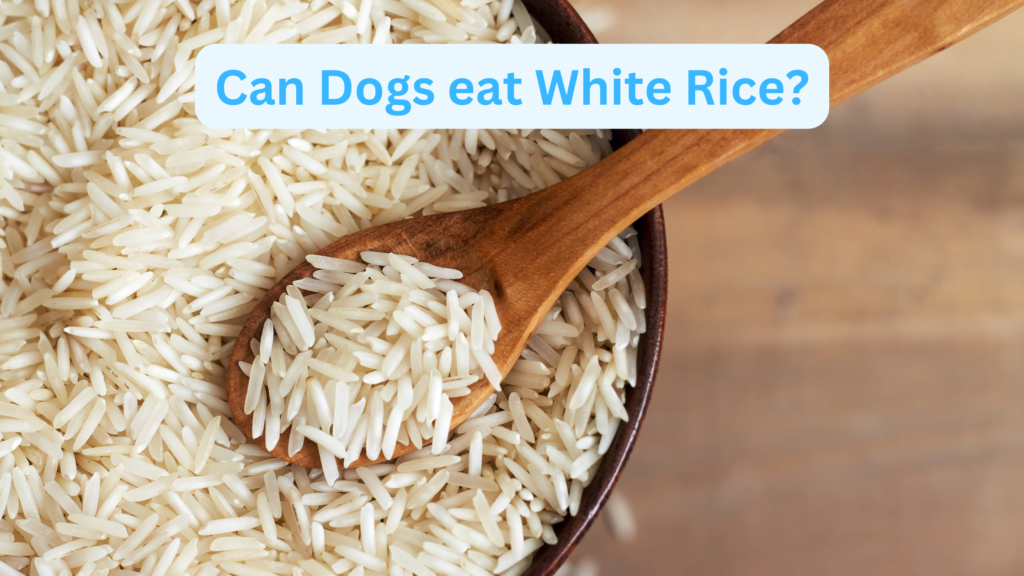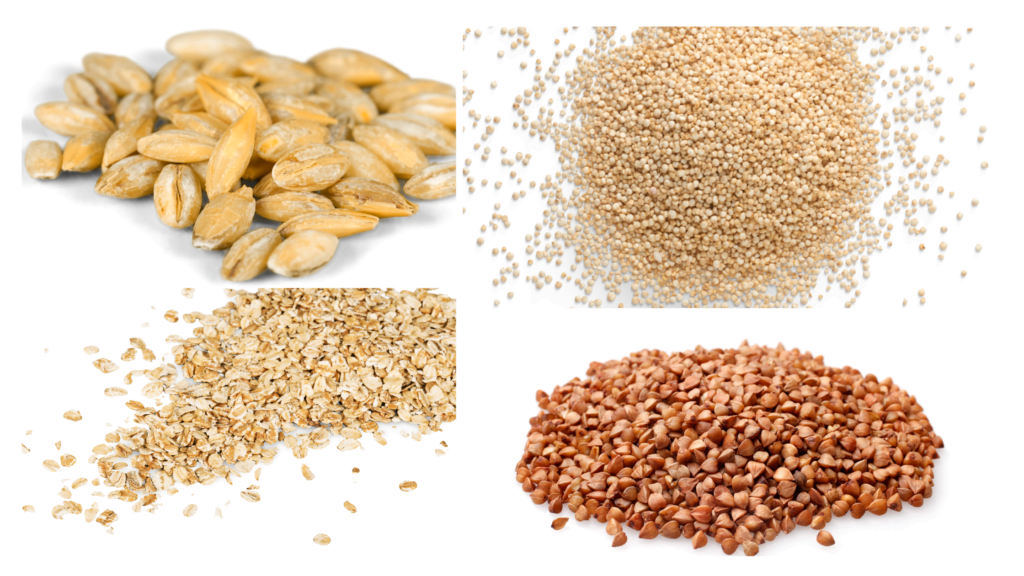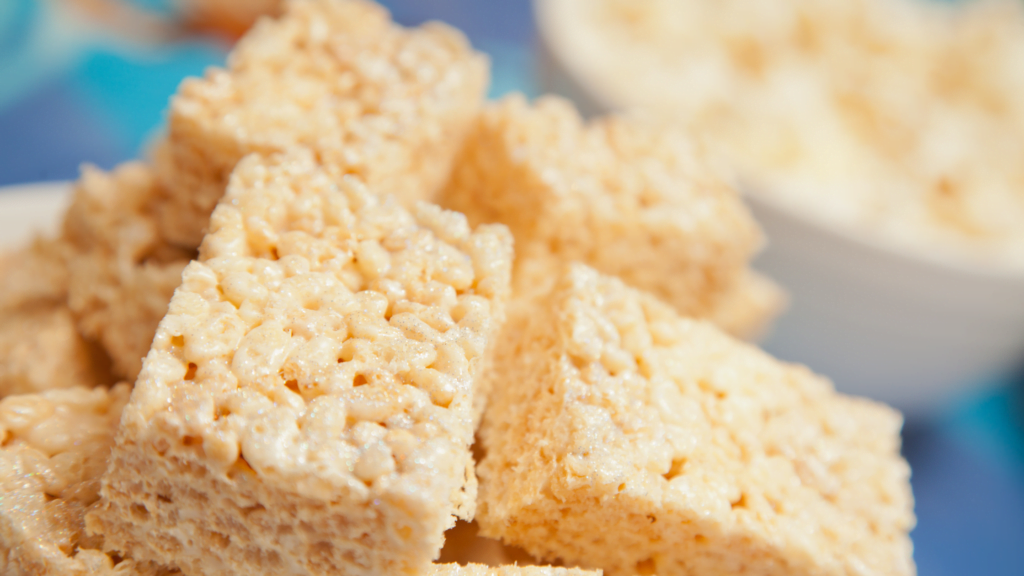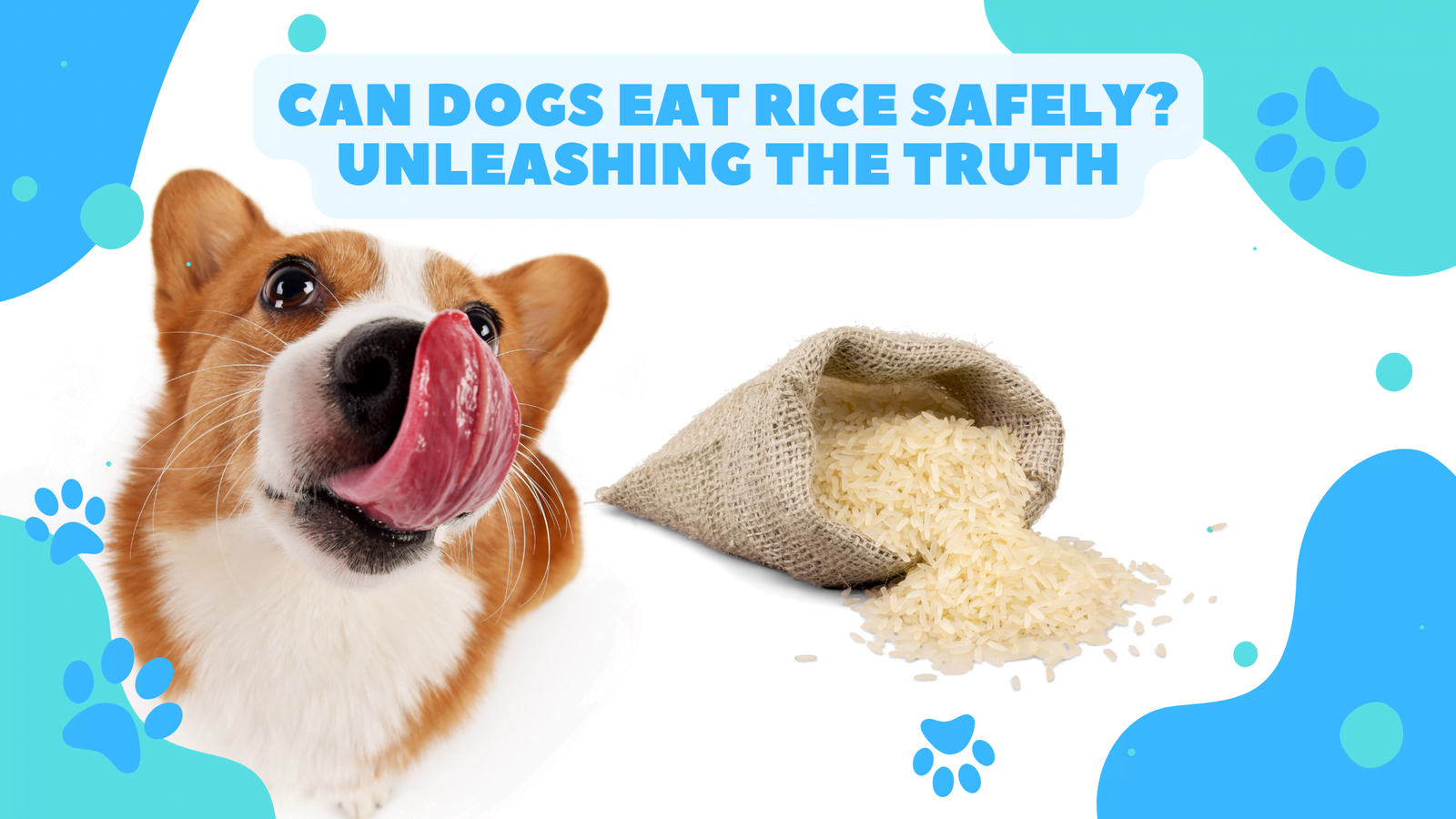Can Dogs Eat Rice Safely? Rice is a staple food for many worldwide and is often considered safe and healthy for dogs. Rice is a good carbohydrate source, providing dogs the energy to maintain their daily activities.
However, not all types of rice are suitable for dogs, and it is essential to know the right kind of rice to feed them and in what quantity.
In this article, we will examine the variations of rice, their health advantages and drawbacks, and the appropriate method to give rice to dogs as part of a nutritious diet.
It’s important to note that while rice can be a safe and nutritious addition to a dog’s diet, it should not be the main component of their diet.
A well-rounded diet incorporating a diversity of protein, fat, and carbohydrate sources, as well as vital vitamins and minerals, is crucial for dogs to maintain optimal health. It is essential to seek the advice of a veterinarian before making any modifications to your dog’s diet.
Types of Rice: White vs. Brown
White and brown rice are the main options when considering the types of rice to feed to dogs.
Can Dogs eat White Rice?

White rice is a popular choice as it is easily digestible and a good source of carbohydrates. This can be beneficial for dogs recovering from illness or surgery. However, it should be noted that white rice has had the bran and the germ removed, making it less nutritious compared to brown rice.
Can Dogs eat Brown Rice?

Brown rice, on the other hand, is a whole grain containing bran and germ, making it more nutritious. Rice is a good source of fiber, vitamins, & minerals. However, it may be harder for dogs to digest and can cause stomach upset if not cooked well. It is recommended to cook brown rice thoroughly and mix it with other food before serving it to dogs. It is always wise to consult a veterinarian before making any changes to your furry’s diet.
It is generally safer to feed white rice to dogs than brown rice. Still, if you want to give your dog the added nutrition of brown rice, it is best to do so in small amounts and after cooking it well. It’s important to note that brown rice should not be fed to dogs with gluten intolerance or other health conditions. Consult your veterinarian before making any changes to your dog’s diet.
Health Benefits and Risks of Feeding Rice to Dogs
Rice can provide several health benefits for dogs when fed in the right amounts. It is a good source of carbohydrates that provides energy for dogs to maintain their daily activities. It’s also a good source of B vitamins such as thiamine, niacin, and vitamin B6. It is also a gluten-free grain, making it a good option for dogs with gluten allergies or sensitivities. Additionally, rice can be a good option for dogs with sensitive stomachs because it’s easy to digest.
However, some risks are also to consider when feeding rice to dogs. One of the main risks is that rice can cause stomach upset in some dogs, primarily if it is provided in large amounts or if the dog is not used to eating rice. Rice can also cause bloating or gas in some dogs. Additionally, the rice must be cooked properly to avoid becoming complex and complicated for dogs to digest.
Another important aspect is the contamination of rice with heavy metals, pesticides, and other harmful chemicals such as Arsenic, which can cause serious health problems for dogs such as Neurotoxicity and diminished brain function, High blood pressure, Vascular disease by narrowing or blocking blood vessels, Cancer (7), Heart disease, Diabetes. Therefore, it is recommended to use organic, high-quality rice when feeding your dog. Organic rice is less likely to contain harmful pesticides or chemicals that can harm your dog’s health.
Feeding rice as a part of a balanced diet can benefit dogs. Still, it should be done in moderation and with the guidance of a veterinarian or a professional. It’s always good to have a variety of food in the diet and not rely heavily on one ingredient.
How Much Rice Can Dogs Eat Safely?
When it comes to feeding rice to dogs, the amount that can be safely consumed will vary depending on the size, weight, and overall health of the dog. As a general guideline, it’s recommended to feed no more than 25% of a dog’s daily caloric intake in rice. This means that if a dog needs to consume 500 calories daily, no more than 125 calories should come from rice.
It’s also important to note that rice should not be the only source of carbohydrates in a dog’s diet. They should also receive carbohydrates from other sources, such as vegetables and fruits. Additionally, dogs also require a balanced diet that includes a variety of protein, fat, and carbohydrate sources as well as essential vitamins and minerals to maintain optimal health.
It’s also important to note that the quantity should be adjusted according to the dog’s needs and activity level. For example, a highly active dog may require more carbohydrates than a less active dog. Therefore, it’s always best to consult a veterinarian or professional before making any changes to your dog’s diet.
Feeding Rice as a Main Diet or Treat
When it comes to feeding rice to dogs, it’s essential to consider whether it should be used as a prominent part of their diet or as a treat. Rice can be a nutritious addition to a dog’s diet when fed in moderation. And as part of a balanced diet that includes a variety of protein, fat, carbohydrate sources, and essential vitamins and minerals. However, it should not be the main component of a dog’s diet.
Suppose you consider using rice as a central part of your dog’s diet. In that case, it’s essential to consult a veterinarian or a professional to ensure your dog receives all the necessary nutrients. It should not be the only source of carbohydrates in a dog’s diet. It should be combined with other protein, fat, and carbohydrate sources. Additionally, it’s essential to use high-quality, organic rice to minimize the risk of contamination with heavy metals and pesticides.
On the other hand, if you consider using rice as a treat for your dog, it can be a good option in small amounts. Rice can be mixed with other ingredients to make homemade dog treats or used as a topping on their food. However, it’s essential to remember that treats should not make up more than 10% of a dog’s daily caloric intake.
Combining Rice with Other Foods for Dogs
When it comes to feeding rice to dogs, it’s essential to consider how it should be combined with other foods to provide a balanced and nutritious diet. Rice is a quality source of carbohydrates and B vitamins, but it should not be the main component of a dog’s diet. Combining rice with other sources of protein, carbohydrates, and fat, as well as essential vitamins and minerals, is critical to ensure that your dog receives all the necessary nutrients.
One way to combine rice with other foods for dogs is to mix it with a protein source such as chicken, fish, or meat. This will give your dog a balance of carbohydrates and protein, which is essential for maintaining good health. For example, you can cook rice with chicken broth and add diced chicken and vegetables to make a healthy and balanced meal for your dog.
Another way to combine rice with other foods for dogs is to use it as a topping on their food. Rice can be mixed with other ingredients, such as cooked vegetables, eggs, or cheese, to make a tasty and nutritious meal for your dog. Additionally, you can make homemade dog treats by mixing rice flour with other ingredients such as peanut butter, eggs, and pumpkin puree.
It’s also important to note that rice should not be fed to dogs as the only source of carbohydrates in their diet. They should also receive carbohydrates from other sources, such as vegetables and fruits.
Special Considerations for Dogs with Health Conditions
When it comes to feeding rice to dogs with health conditions, it’s essential to consult a veterinarian or professional before making any changes to their diet. Certain health conditions can affect a dog’s ability to digest and absorb certain nutrients. , and it’s essential to ensure that their diet is tailored to meet their specific needs.
For example, dogs with diabetes should be fed a diet low in carbohydrates and sugar. Limit or avoid rice altogether. Similarly, dogs with kidney disease may need to restrict their protein and phosphorus intake. And it’s essential to ensure that the protein source combined with the rice is appropriate for their condition.
Dogs with food allergies or sensitivities may also need to avoid certain types of rice or combine them with other ingredients. For example, dogs with gluten intolerance should avoid wheat-based rice products, and it’s essential to use gluten-free rice options.
Additionally, some dogs may have trouble digesting rice because of its high fiber content, which can cause stomach upset or diarrhea. Suppose your dog is experiencing digestive problems after consuming rice. In that case, it’s best to consult a veterinarian to rule out any underlying health conditions or food allergies.
Alternative Grains for Dogs

Rice is not the only grain option available for dogs. Many alternative grains can be included in a dog’s diet, providing similar nutritional benefits. Some of the alternative grains that can be fed to dogs include:
- Oatmeal: Oatmeal is an excellent alternative to rice for dogs as it is a good source of fiber, vitamins, and minerals. Oatmeal can be fed cooked or raw and mixed with other ingredients such as meat, vegetables, and fruits to make a healthy and balanced meal for your dog.
- Barley: Barley is another alternative grain that can be fed to dogs. It’s a good source of fiber, vitamins, and minerals and can be used similarly to rice in recipes. Barley can also be used as a substitute for rice in homemade dog food recipes.
- Quinoa: Quinoa is a nutrient-rich grain that is often considered a superfood. It’s a good protein, fiber, and essential amino acid source. Quinoa can be cooked and served as a side dish for dogs or mixed with other ingredients to make a healthy and nutritious meal.
- Buckwheat: Buckwheat is a gluten-free grain that is a good source of fiber, vitamins, and minerals. It can be fed to dogs cooked or raw and mixed with other ingredients such as meat, vegetables, and fruits to make a healthy and balanced meal.
When considering adding new food to your dog’s diet, it’s crucial to introduce it gradually to allow their digestive system to adjust. This will also enable you to watch for any adverse reactions. It is always advisable to seek the advice of a veterinarian or professional before making any changes to your dog’s diet.
Preparing Rice for Dogs: Cooked vs. Uncooked
When preparing rice for dogs, there are two main options: cooked and uncooked. Each option has its own benefits and risks, and it’s essential to consider them before deciding.
Cooked Rice for dogs: Cooking rice for dogs is the most common way to prepare it, as it makes it easy to digest and kills any potential bacteria. Cooked rice can be mixed with other ingredients such as meat, vegetables, and fruits to create a healthy and balanced meal for your dog. It can also be served as a side dish with a dog’s regular diet.
Uncooked Rice for dogs: Uncooked rice, on the other hand, is not recommended for dogs as it can be challenging to digest, and it may cause stomach upset or diarrhea. Uncooked rice also contains phytic acid, which can bind to minerals such as zinc and iron, making them less available to dogs. Additionally, uncooked rice can contain bacteria such as E. coli and salmonella that can cause food poisoning if not handled and stored correctly.
Can Dogs Eat Different Forms of Rice?
Here are some frequently asked questions about different forms of rice and whether or not they are safe for dogs to eat:
Can dogs eat rice pudding?
Rice pudding is typically made with milk and sugar, which can harm dogs. It’s best to avoid giving rice pudding to dogs and instead opt for a healthier alternative, such as plain cooked rice mixed with some vegetables or meat.
Can dogs eat rice cakes?
Rice cakes are usually made with processed rice and can be high in salt and sugar. In general, it’s best to avoid giving rice cakes to dogs and instead opt for a healthier alternative, such as plain cooked rice mixed with some vegetables or meat.
Can dogs eat rice flour?
Rice flour is safe for dogs to eat in moderation. It can be used as an ingredient in homemade dog food or treat recipes, but it should be something other than the dog’s main diet.
Can dogs eat rice bran?
Rice bran is safe for dogs to eat in moderation. It’s a good source of fiber and can be used as an ingredient in homemade dog food or treat recipes but should not be fed as a primary diet to dogs.
Can dogs eat wild rice?
Wild rice is safe for dogs to eat in moderation. It’s a good source of nutrients and can be used as an ingredient in homemade dog food or treat recipes, but it should be kept as a supplement for dogs.
Can dogs eat rice noodles?
Rice noodles are safe for dogs to eat in moderation. They can be used as an ingredient in homemade dog food or treat recipes but should not be fed as a primary diet for dogs.
Can dogs eat rice cereal?
Rice cereal is typically made with processed rice and can be high in sugar and salt. It’s best to avoid giving rice cereal to dogs and instead opt for a healthier alternative, such as plain cooked rice mixed with some vegetables or meat.
Can dogs eat rice milk?
Rice milk is typically made with processed rice and can be high in sugar and salt. It’s best to avoid giving rice milk to dogs and instead opt for a healthier alternative, such as water or a low-fat, unsweetened milk alternative.
Can dogs eat fried rice?
Fried rice is typically made with processed rice and can be high in salt and oil. It’s best to avoid giving fried rice to dogs and instead opt for a healthier alternative, such as plain cooked rice mixed with some vegetables or meat.
Can dogs eat sticky rice?
Sticky rice is safe for dogs to eat in moderation. It can be used as an ingredient in homemade dog food or treat recipes but should not be fed as a primary diet for dogs.
Can dogs eat jasmine rice?
Jasmine rice is safe for dogs to eat in moderation. It can be used as an ingredient in homemade dog food or treat recipes but should not be fed as a primary diet for dogs.
Can dogs eat basmati rice?
Basmati rice is safe for dogs to eat in moderation. It can be used as an ingredient in homemade dog food or treat recipes but should not be fed as a primary diet for dogs.
Can dogs eat sushi rice?
Sushi rice is typically made with processed rice and can be high in salt and sugar. It’s best to avoid giving sushi rice to dogs and instead opt for a healthier alternative, such as plain cooked rice mixed with some vegetables or meat.
Can dogs eat Rice Krispie treats?

Dogs can technically eat rice krispies treats, but it is not recommended as it is not a healthy food choice. Rice Krispies treats are often made with marshmallows and butter, which can be high in sugar and fat. These ingredients can lead to weight gain, pancreatitis, and other health issues in dogs. Additionally, many store-bought rice krispies treats may contain artificial flavors and preservatives that can harm dogs.
When giving your dog a treat, it is best to opt for treats specifically made for dogs or homemade treats prepared with safe ingredients. Suppose you have doubts about the tasty treat you want to give your dog. In that case, it is recommended to consult your veterinarian for guidance.
Can dogs eat rice every day?
Including rice in a dog’s diet can be safe, but it should not be the sole source of their nutrition. Rice can be used as a carbohydrate source and is an excellent addition to a balanced diet for dogs. However, it is essential to note that too much rice can lead to weight gain and other health issues.
It is suggested to provide a moderate quantity of rice to dogs as part of a well-rounded diet that encompasses a variety of proteins, fruits, and vegetables. Rice should not be fed as the main ingredient or staple in a dog’s diet, as it lacks essential nutrients that dogs need to maintain good health.
It is always a good idea to consult a veterinarian before making any changes to your dog’s diet. They will provide you with the best recommendations and guidance regarding daily food portions. They can also help you understand your dog’s specific nutritional needs based on age, size, and activity level. They can also help you spot any potential health issues related to diet.
Storing and Serving Leftover Rice for Dogs

Storing and serving leftover rice for dogs is an important aspect to consider when feeding rice to your dog. Here are a few tips to keep in mind:
- Store leftover rice in an airtight container in the refrigerator to prevent it from going wrong. Rice can be stored in the fridge for up to four days.
- Ensure the rice is cooked and cooled completely before serving it to your dog. Hot rice can cause burns or injuries to your dog’s mouth and throat.
- Reheat the rice in the microwave or on the stovetop before serving. This will help to kill any bacteria that may have formed while the rice was in the fridge.
- Please do not add any additional ingredients to the rice when reheating it. Rice should be fed plain to dogs.
- Be mindful of portion size when serving rice to your dog. A serving size for a dog is typically smaller than a serving size for a human.
- Observe your dog for allergic reactions or digestive issues after feeding rice for the first time. If your dog has any health conditions, it’s always better to consult your veterinarian before serving rice to them.
By following these tips, you can ensure that leftover rice is stored and served safely to your dog, and you can also ensure that your dog is getting the right amount of food.
Flavored Rice for Dogs: Pros and Cons
Flavored rice may seem convenient and tasty, but it is essential to consider the pros and cons before feeding it to your dog.
Pros:
- Some flavored rice for dogs may contain added vitamins and minerals, which can benefit your dog’s health.
- Flavored rice may make it easier get picky dogs to eat their food.
- Some flavored rice varieties contain added protein, which can be beneficial for dogs who have difficulty digesting certain types of protein.
Cons:
- Many flavored rice products for dogs contain added salt, sugar, and preservatives, which can harm your dog’s health.
- Some flavored rice products may have artificial colors and flavors, harming your dog’s health.
- Some flavored rice may also contain gluten, damaging dogs with gluten allergies.
- Some flavored rice products may be high in calories, which can lead to weight gain if fed in excess.
It’s always best to read the ingredient list on the packaging and consult with your veterinarian before feeding flavored rice to your dog. It’s also best to provide rice in small amounts to monitor the dog’s reaction if your dog has any health condition.
It is always recommended to feed your dog plain rice and add healthy, natural flavors like fresh herbs, fruits, and vegetables. This way, you can ensure that your dog gets a balanced diet without unnecessary additives.
How to Add Rice to Your Dog’s Diet
Adding rice to your dog’s diet can be a great way to provide them with additional nutrition and energy. Here are a few tips on how to add rice to your dog’s diet:
- Start with small portions: When introducing rice to your dog’s diet, start with small quantities to see how they react. Gradually increase the amount of rice as your dog gets used to it.
- Cook the rice properly: Ensure it is properly before giving it to your dog. Rice should be cooked until it is soft and easy to digest.
- Mix with other foods: Mixing rice with different foods like meat, vegetables, or broth can make it more palatable and easier to digest for your dog.
- Consider the type of rice: White rice is a good option for dogs as it is easily digestible. Brown rice is also a good option, but it may take longer to digest and may cause gas.
- Monitor your dog’s reaction: Keep an eye on your dog for allergic reactions or digestive issues after introducing rice to its diet.
- Consult your veterinarian: If you need help adding rice to your dog’s diet or if your dog has any health conditions, it’s best to consult with your veterinarian.
By following these tips, you can add rice to your dog’s diet safely and healthily and ensure that your dog is getting the nutrition they need.
Conclusion: Rice as a Part of a Balanced Dog Diet
In conclusion, rice can benefit a dog’s diet as it provides energy and essential nutrients like carbohydrates and fiber. However, it is important to remember that rice should be fed in moderation and with a balanced diet that includes many protein sources, vegetables, and fruits.
White rice is a good option for dogs as it is easily digestible, while brown rice is also a good option, but it may take longer to digest and may cause gas. It’s best to consult your veterinarian before introducing rice to your dog’s diet, especially if your dog has any health conditions or food allergies.
When feeding rice, it’s essential to ensure it is adequately cooked. And mixed with other foods for optimal palatability and digestibility. It’s also necessary to monitor your dog’s reaction and be mindful of the type of rice and the amount you are feeding.
Ultimately, a balanced diet that includes a variety of foods is the key to keeping your dog healthy and happy. Rice can be a great addition to a dog’s diet, but it should never be the sole source of nutrition.

